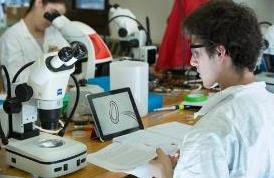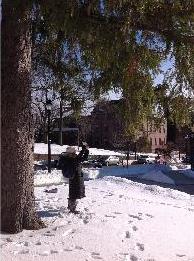
iPads were a natural fit for the Yale Nature Walk project, as a set of the Apple tablets had already been purchased for use with the microscopes in the labs. The microscopes have special cameras  attached that are able to transmit data to the iPads via a wireless network allowing each student to view specimen on their own iPads. Students are then able to capture an image or video of the specimen, add annotations, and finally save their work to a lab notebook.
attached that are able to transmit data to the iPads via a wireless network allowing each student to view specimen on their own iPads. Students are then able to capture an image or video of the specimen, add annotations, and finally save their work to a lab notebook.
 In keeping with Prof. Wells’ vision and the theme of the class to incorporate a more interactive experience in the field, as well as reinforce learning outcomes, it was determined that the iPads would be a good tool for capturing tree data. With a mobile-friendly Drupal web site, students are able to input data directly into their assigned pages, while using other specific iPad apps to help locate, measure and take notes on their trees. The apps used for filed work include Tree Height Pro, ArcGIS Collector, and a QR code reader for scanning the tree sign each student creates.
In keeping with Prof. Wells’ vision and the theme of the class to incorporate a more interactive experience in the field, as well as reinforce learning outcomes, it was determined that the iPads would be a good tool for capturing tree data. With a mobile-friendly Drupal web site, students are able to input data directly into their assigned pages, while using other specific iPad apps to help locate, measure and take notes on their trees. The apps used for filed work include Tree Height Pro, ArcGIS Collector, and a QR code reader for scanning the tree sign each student creates.
As the project matures, finding more agnostic mobile apps and input methods will have to be evaluated to adapt with technology changes. Prof Wells also hopes to incorporate a gaming aspect into the project, as well as broaden the outreach to collaborate with other colleges and universities.
Keep in mind that iPads should not be a limiting factor, as other mobile devices can be used as long as appropriate planning is done ahead of time. In fact, other higher education institutions have created similar online apps for fieldwork. Ball University develped an Android app called Traveler, and Williams College has a digital lab notebook freely available for download from Github.